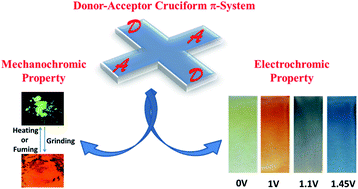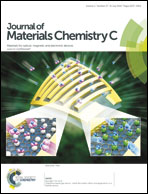A donor–acceptor cruciform π-system: high contrast mechanochromic properties and multicolour electrochromic behavior†
Abstract
A donor–acceptor (D–A) cruciform conjugated luminophore DMCS-TPA was designed and synthesized. The DMCS-TPA solid shows both aggregation induced emission (AIE) effect and high contrast mechanochromic (MC) behavior with a remarkable spectral shift of 87 nm. The obvious fluorescence switching from yellowish green to orange can be realized by pressing at only 10 MPa or simply grinding. The photophysical properties, theory calculation and XPS results demonstrate that the extension of the conjugation length and subsequent enhancement of intramolecular charge transfer (ICT) transition are responsible for the improved MC performance. In addition, DMCS-TPA is readily deposited on the ITO electrode surface by the electrochemical method to form an electrochromic (EC) film with multiple colours showing (light green at 0 V, red at 1 V, grey at 1.1 V and blue at 1.45 V) and a high optical contrast of 65% at 769 nm. The results suggest that incorporation of electroactive moieties into luminophores to constitute D–A cruciform conjugated structures is a promising design strategy for preparing dual functional materials combining MC and EC properties.


 Please wait while we load your content...
Please wait while we load your content...